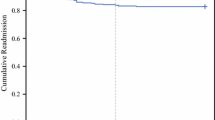Abstract
Purpose
Cytoreductive surgery/hyperthermic intraperitoneal chemotherapy (CRS/HIPEC) for peritoneal carcinomatosis is a morbid endeavor. Despite improvement in perioperative management of these patients, there are subsets of patients requiring hospital readmission after discharge. We sought to identify variables associated with readmission rates for CRS/HIPEC.
Methods
We conducted a retrospective review of CRS/HIPEC cases at the University of Cincinnati between 1999 and 2014. Patient-, tumor-, and treatment-specific characteristics were evaluated. The association between patient- and outcome-specific variables for 30- and 90-day readmission were evaluated.
Results
Of 215 CRS/HIPEC patients, the 7-, 30-, and 90-day readmission rates were 9.8 % (n = 21), 14.9 % (n = 32), and 21.4 % (n = 46), respectively. The most common reasons for readmission within 90 days included abdominal pain (n = 14), intra-abdominal abscess (n = 9), malnutrition/failure to thrive (n = 8), and bowel obstruction (n = 7). The primary factor associated with readmission at all time points (7, 30, and 90 days) was the presence of an enterocutaneous fistula (p < 0.01). Six patients (2.8 %) had multiple readmissions; 3 of these had ECF. Factors not associated with higher admission rates included sex, age, race, operative blood loss, pancreatectomy or liver resection at the index operation, and postoperative complications of wound infection, line infection, and thromboembolic events.
Conclusions
In patients undergoing CRS/HIPEC, readmission was primarily associated with poor pain control, malnutrition, and infectious complications. Patients with enterocutaneous fistula were also disproportionately readmitted multiple times. These data should inform clinicians about patients at high risk for readmission after CRS/HIPEC and encourage more comprehensive coordination of postdischarge planning and care for specific patient populations.

Similar content being viewed by others
References
Stitzenberg KB, Chang Y, Smith AB, Nielsen ME. Exploring the burden of inpatient admissions after major cancer surgery. J Clin Oncol. 2015;33:455–64.
Ahmad SA, Kim J, Sussman JJ, et al. Reduced morbidity following cytoreductive surgery and intraperitoneal hyperthermic chemoperfusion. Ann Surg Oncol. 2004;11:387–92.
Stephens AD, Alderman R, Chang D, et al. Morbidity and mortality analysis of 200 treatments with cytoreductive surgery and hyperthermic intraoperative intraperitoneal chemotherapy using the coliseum technique. Ann Surg Oncol. 1999;6:790–6.
Sugarbaker PH. Peritonectomy procedures. Ann Surg. 1995;221:29–41.
Verwaal VJ, van Tinteren H, Ruth SV, et al. Toxicity of cytoreductive surgery and hyperthermic intra-peritoneal chemotherapy. J Surg Oncol. 2004; 85:61–7.
Jencks SF, Williams MV, Coleman EA, et al. Rehospitalizations among patients in the medicare fee-for-service program. N Engl J Med. 2009;360:1418–28.
Jacobs BL, Zhang Y, Tan HJ, Ye Z, Skolarus TA, Hollenbeck BK. Hospitalization trends after prostate and bladder surgery: implications of potential payment reforms. J Urol. 2013;189:59–65.
Leow JJ, Gandaglia G, Sood A, et al. Readmissions after major urologic cancer surgery. Can J Urol. 2014;21:7537–46.
Ahmad SA, Edwards MJ, Sutton JM, et al. Factors influencing readmission after pancreaticoduodenectomy: a multi-institutional study of 1302 patients. Ann Surg. 2012;256:529–37.
Hyder O, Dodson RM, Nathan H, et al. Influence of patient, physician, and hospital factors on 30-day readmission following pancreatoduodenectomy in the United States. JAMA Surg. 2013;148:1095–102.
Shah SP, Xu T, Hooker CM, et al. Why are patients being readmitted after surgery for esophageal cancer? J Thorac Cardiovasc Surg. 2015;149:1384–9.
Sundaram A, Srinivasan A, Baker S, Mittal SK. Readmission and risk factors for readmission following esophagectomy for esophageal cancer. J Gastrointest Surg. 2015;19:581–5.
Hu Y, McMurry TL, Isbell JM, Stukenborg GJ, Kozower BD. Readmission after lung cancer resection is associated with a 6-fold increase in 90-day postoperative mortality. J Thorac Cardiovasc Surg. 2014;148:2261–7.
McDevitt J, Kelly M, Comber H, et al. A population-based study of hospital length of stay and emergency readmission following surgery for non-small-cell lung cancer. Eur J Cardiothorac Surg. 2013;44:e253–9.
Verwaal VJ, van Ruth S, de Bree E, et al. Randomized trial of cytoreduction and hyperthemic intraperitoneal versus systemic chemotherapy and palliative surgery in patients with peritoneal carcinomatosis of colorectal cancer. J Clin Oncol. 2003;21:3737–43.
Jafari MD, Halabi WJ, Stamos MJ, et al. Surgical outcomes of hyperthermic intraperitoneal chemotherapy: analysis of the American College of Surgeons National Surgical Quality Improvement Program. Pacific Coast Surgical Association. JAMA. 2014;149:170–5.
Glehen O, Gilly FN, Boutitie F, et al. French Surgical Association. Toward curative treatment of peritoneal carcinomatosis from nonovarian origin by cytoreductive surgery combined with perioperative intraperitoneal chemotherapy: a multi-institutional study of 1290 patients. Cancer. 2010;116:5608–18.
Halkia E, Efstathiou E, Rogdakis A, et al. Digestive fistulas after cytoreductive surgery and HIPEC in peritoneal carcinomatosis. J BUON. 2015;20(1 suppl):S60–3.
Haslinger M, Francesecutti V, Attwood K, et al. A contemporary analysis of morbidity and outcomes in cytoreduction/hyperthermic intraperitoneal chemoperfusion. Cancer Med. 2013;2:334–42.
da Silva RG, Sugarbaker PH. Analysis of prognostic factors in seventy patients having a complete cytoreduction plus perioperative intraperitoneal chemotherapy for carcinomatosis from colorectal cancer. J Am Coll Surg. 2006;203:878–86.
Votanopoulos KI, Swords DS, Swett KR, et al. Obesity and peritoneal surface disease: outcomes after cytoreductive surgery with hyperthermic intraperitoneal chemotherapy for appendiceal and colon primary tumors. Ann Surg Oncol. 2013;20:3899–904.
Austin F, Mavanur A, Sathaiah M, et al. Aggressive management of peritoneal carcinomatosis from mucinous appendiceal neoplasms. Ann Surg Oncol. 2013;19:1386–93.
Randle RW, Doud AN, Levine EA, et al. Peritoneal surface disease with synchronous hepatic involvement treated with cytoreductive surgery (CRS) and hyperthermic intraperitoneal chemotherapy (HIPEC). Ann Surg Oncol. 2015;22:1634–8.
Disclosure
The authors declare no conflict of interest.
Author information
Authors and Affiliations
Corresponding author
Rights and permissions
About this article
Cite this article
Martin, A.S., Abbott, D.E., Hanseman, D. et al. Factors Associated with Readmission After Cytoreductive Surgery and Hyperthermic Intraperitoneal Chemotherapy for Peritoneal Carcinomatosis. Ann Surg Oncol 23, 1941–1947 (2016). https://doi.org/10.1245/s10434-016-5109-3
Received:
Published:
Issue Date:
DOI: https://doi.org/10.1245/s10434-016-5109-3




